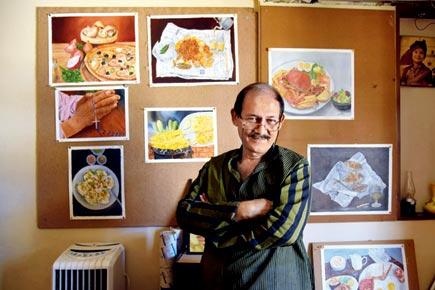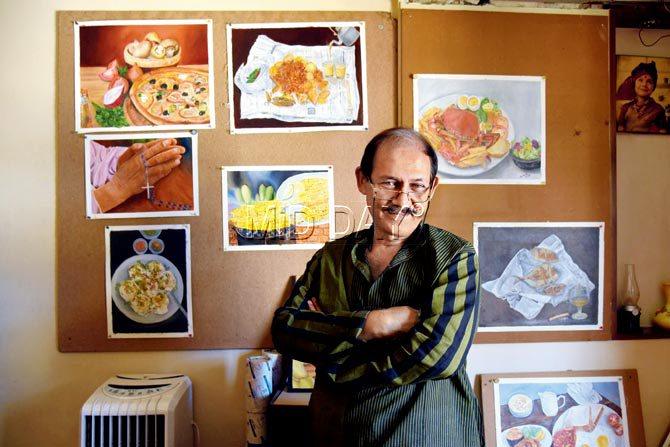Dr Hemant Bhansali, one of the country’s top laproscopic surgeons, handles the dissector and paintbrush with equal flair

ADVERTISEMENT
Our mouth waters when we enter Dr Hemant Bhansali’s study at his Vile Parle East home. We eye the plate of crispy samosa with spicy green chutney that sits on the canvas.
It’s only the strong smell of oil paint that reminds us that the menu is not real.

The 61-year-old laparoscopic surgeon at Nanavati Hospital and Karuna Hospital, who also is the director of higher education for fellowship in surgery for Maharashtra University of Health Sciences (MUHS), is dressed in a bottle-green kurta. He wears his spectacles on the edge of his nose. He says he took up painting three years ago, as a passion. Six months ago, his daughter Juilee created a website showcasing his works, and in April, at a flea market, he sold eight canvases. Later this month, six to seven paintings will be on sale at the India Art exhibition at Nehru Centre.
“My surgical skills help me paint with precision, and painting helps keeps my hand stable,” says Bhansali who studied medicine at Humana University Hospital in Louisville, America, in 1989, and trained under Dr Gary Vitale and Dr Perisat — fathers of laparoscopy in US.
Scientific streak
“Laparoscopy replaces the need to cut open a body. An open surgery causes blood loss, tissue damage and long recuperation periods. We make a one-centimetre incision in the body, to let gas pass through and another 5-10 mm puncture to insert a dissector which has a camera attached to it. The image is transmitted on a screen through a telescope in a zoomed in proportion. The recovery period is 24-48 hours,” he explains.
His daughter steps into the room with juice and goodies. “Not near that canvas. I can’t have any spills here,” Bhansali tells her. She leaves us to chat, but stops mid-way. “He can speak about laparoscopy all day. It is alright to ask him to stop,” she laughs.

Passing on the knowledge
“In 1992, when I attempted setting up a laparoscopy unit in Mahim, people thought I was crazy. I sold my house worth R16 lakh to set it up. Initially, the instruments were not available easily, the anesthetic didn’t know how to dose the patient,” says Bhansali, who has since then trained 18,000 doctors.
Bhansali’s first lessons were conducted on pigs, whose anatomy is similar to a human’s. I requested the state government to allow a structured training programme where students could learn under specialised doctors,” says Bhansali, who completed his PhD in laparoscopy in 2012 after six gruelling years. By then, he had many significant patents to his name, including knotting techniques. Interestingly, he is presently co-working on an experiment to invent an automatic suturing machine with an IIT mechanical engineer.
21-hour days
As he continued to paint, he decided to learn under a teacher after 2012. Bhansali then made the late American Bobross his “guru”, learning his wet-on-wet technique through DVDs and online tutorials.
“I began with landscapes but my wife and strongest critic, Dr Shailaja, told me that no one paints food, and I should take that up,” Bhansali says with pride. His passion took him to Russsia where he was bowled over by the art museums in Pittsburg. “There, I connected with two great portrait artists — Igor Saharov and Cergi Gusev. Gusev was known as the Bob Ross of Russian art. He had also been in charge of restoration work for old paintings in Russian palaces,” says Bhansali, who ordered their painting tutorials. “But, they came to me in Russian. All I did was imitate their strokes,” he smiles triumphantly.
His first food canvas, which he proudly holds up for us, is a idli and medu vada plate. “The challenge was the crust of the vada, the near-perfect white of the idli and the exact shade of sambhar. Food has so much character, and my attempt is always to make the viewer want to grab a bite,” he says.
Over the years, he has procured online tutorials by Will Camp, Robert Hagens and Omar Martiz, a Mexican hyper-realistic painter. “I have also learned the Flemish practice of nine-layer paintings. A painting in Versailles makes you want to step into it. It takes one and a half months to create such a work,” says Bhansali, pointing out to a painting of monks in yellow robes that he recently finished. “My profession grants me the close proximity of observing veins, tendons, skin wrinkles. And thus, I can replicate them on canvas.”
Ask him how he finds time and he says he sleeps three hours every night and is up by 4.30 am for his first round of art work. At 7.30 am, he leaves for New Law College at Ruparel where he is studying medico law. At 10 am, he checks into Nanavati Hospital for surgeries and consultation. “Then, I juggle between studies, conferences and lectures. But I paint, every minute of my free time,” says Bhansali.
“The next time you drop in, I would have mastered the 3D technique,” he promises.
 Subscribe today by clicking the link and stay updated with the latest news!" Click here!
Subscribe today by clicking the link and stay updated with the latest news!" Click here!







